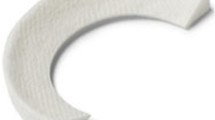Abstract
Purpose
The purpose of this study was to assess the effect of polyethylene terephthalate (PET) on proliferation, differentiation, and attachment of ovine meniscocytes seeded in a hyaluronic acid/polycaprolactone biomaterial (BF-1)
Methods
BF-1 (30 % hyaluronic acid and 70 % polycaprolactone) cylinders with PET (CO-PET) or without PET, were seeded with 2x106 ovine meniscus cells. The specimens were harvested in triplets at 12 hours, seven, 14, 21 and 28 days. DNA content was measured to test proliferation, histological analysis for cell morphology, and biochemical assessment of glycosaminoglycan content and RT-PCR for type I and II collagen were used to assess differentiation, with immunohistochemistry as post-translational control. Attachment was evaluated by electronic microscopy at 28 days.
Results
DNA content was consistent and equal across groups, suggesting no effect of PET on cell proliferation. However, the BF-1 CO-PET showed a higher percentage of cells with spherical morphology which is typical for a chondrocytic phenotype. This biomaterial with PET also showed a higher type II collagen mRNA expression and an eightfold higher GAG-content than the material without PET. Small amounts of type I collagen mRNA expression were present on both materials at all time points. PCR results were confirmed by immunohistochemistry.
Conclusion
Addition of PET to a hyaluronic acid/polycaprolactone biomaterial enhances a cartilaginous phenotype, increased type II collagen mRNA expression and a higher GAG production in ovine mensicocytes.





Similar content being viewed by others
References
Mow VC, Arnoczky SP (1992) Knee. Meniscus: basic and clinical foundations. Raven, New York
Seedhom BB, Dowson D, Wright V (1974) Proceedings: functions of the menisci. A preliminary study. Ann Rheum Dis 33(1):111
Krause WR, Pope MH, Johnson RJ, Wilder DG (1976) Mechanical changes in the knee after meniscectomy. J Bone Joint Surg Am 58(5):599–604
Fairbank TJ (1948) Knee joint changes after meniscectomy. J Bone Joint Surg Br 30:664–670
Wyland DJ, Guilak F, Elliott DM, Setton LA, Vail TP (2002) Chondropathy after meniscal tear or partial meniscectomy in a canine model. J Orthop Res 20(5):996–1002
Roos H, Lauren M, Adalberth T, Roos EM, Jonsson K, Lohmander LS (1998) Knee osteoarthritis after meniscectomy: prevalence of radiographic changes after twenty-one years, compared with matched controls. Arthritis Rheum 41(4):687–693
Arnoczky SP, Warren RF (1983) The microvasculature of the meniscus and its response to injury. An experimental study in the dog. Am J Sports Med 11(3):131–141
Pecina M, Vukicevic S (2007) Biological aspects of bone, cartilage and tendon regeneration. Int Orthop 31(6):719–720
Ivkovic A, Pascher A, Hudetz D, Maticic D, Jelic M, Dickinson S, Loparic M, Haspl M, Windhager R, Pecina M (2010) Articular cartilage repair by genetically modified bone marrow aspirate in sheep. Gene Ther 17(6):779–789
Buma P, Ramrattan NN, van Tienen TG, Veth RP (2004) Tissue engineering of the meniscus. Biomaterials 25(9):1523–1532
Ivkovic A, Marijanovic I, Hudetz D, Porter RM, Pecina M, Evans CH (2011) Regenerative medicine and tissue engineering in orthopaedic surgery. Front Biosci (Elite Ed) 3:923–944
Arnoczky SP (1999) Building a meniscus. Biologic considerations. Clin Orthop Relat Res (367 Suppl):S244-253
Inui A, Kokubu T, Makino T, Nagura I, Toyokawa N, Sakata R, Kotera M, Nishino T, Fujioka H, Kurosaka M (2010) Potency of double-layered poly L-lactic acid scaffold in tissue engineering of tendon tissue. Int Orthop 34 (8):1327–1332
Hutmacher DW (2000) Scaffolds in tissue engineering bone and cartilage. Biomaterials 21(24):2529–2543
Farndale RW, Buttle DJ, Barrett AJ (1986) Improved quantitation and discrimination of sulphated glycosaminoglycans by use of dimethylmethylene blue. Biochim Biophys Acta 883(2):173–177
Nehrer S, Breinan HA, Ramappa A, Young G, Shortkroff S, Louie LK, Sledge CB, Yannas IV, Spector M (1997) Matrix collagen type and pore size influence behaviour of seeded canine chondrocytes. Biomaterials 18(11):769–776
Almarza AJ, Athanasiou KA (2004) Design characteristics for the tissue engineering of cartilaginous tissues. Ann Biomed Eng 32(1):2–17
Dorotka R, Windberger U, Macfelda K, Bindreiter U, Toma C, Nehrer S (2005) Repair of articular cartilage defects treated by microfracture and a three-dimensional collagen matrix. Biomaterials 26(17):3617–3629
Solchaga LA, Dennis JE, Goldberg VM, Caplan AI (1999) Hyaluronic acid-based polymers as cell carriers for tissue-engineered repair of bone and cartilage. J Orthop Res 17(2):205–213
Solchaga LA, Yoo JU, Lundberg M, Dennis JE, Huibregtse BA, Goldberg VM, Caplan AI (2000) Hyaluronan-based polymers in the treatment of osteochondral defects. J Orthop Res 18(5):773–780
Chiari C, Koller U, Kapeller B, Dorotka R, Bindreiter U, Nehrer S (2008) Different behavior of meniscal cells in collagen II/I,III and Hyaff-11 scaffolds in vitro. Tissue Eng Part A 14(8):1295–1304
Chiari C, Koller U, Dorotka R, Eder C, Plasenzotti R, Lang S, Ambrosio L, Tognana E, Kon E, Salter D, Nehrer S (2006) A tissue engineering approach to meniscus regeneration in a sheep model. Osteoarthr Cartil 14(10):1056–1065
Nehrer S, Domayer S, Dorotka R, Schatz K, Bindreiter U, Kotz R (2006) Three-year clinical outcome after chondrocyte transplantation using a hyaluronan matrix for cartilage repair. Eur J Radiol 57(1):3–8
Nakata K, Shino K, Hamada M, Mae T, Miyama T, Shinjo H, Horibe S, Tada K, Ochi T, Yoshikawa H (2001) Human meniscus cell: characterization of the primary culture and use for tissue engineering. Clin Orthop Relat Res (391 Suppl):S208-218
Acknowledgments
This research was supported by the European Commission Fifth Framework Program (Project title: Innovative materials and technologies for a bio-engineered meniscus substitute, Project No GRD1-2001-40401, Contract No G5RD-CT-2002-00703). The authors wish to thank Guenther Brand and Ruth Gruebl for their assistance with the preparation of the histological specimens.
Conflict of interest
The authors declare that they have no conflict of interest.
Author information
Authors and Affiliations
Corresponding author
Rights and permissions
About this article
Cite this article
Koller, U., Nehrer, S., Vavken, P. et al. Polyethylene terephthalate (PET) enhances chondrogenic differentiation of ovine meniscocytes in a hyaluronic acid/polycaprolactone scaffold in vitro. International Orthopaedics (SICOT) 36, 1953–1960 (2012). https://doi.org/10.1007/s00264-012-1534-5
Received:
Accepted:
Published:
Issue Date:
DOI: https://doi.org/10.1007/s00264-012-1534-5




